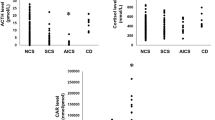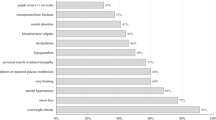Abstract
The study aimed to retrospectively evaluate the reliability of the diagnostic and location tests in Cushing’s Syndrome (CS). Eighty-seven patients diagnosed with CS between 1995 and 2007 by Endocrinology Metabolism Department of Cerrahpasa Medical School were included in the study. The control group consisted of 91 patients who presented to the outpatient clinic because of obesity. The diagnostic tests were as follows: 1 mg dexamethasone suppression test (DST), 24-h urinary free cortisol (UFC), midnight cortisol level (MCL), ACTH level and overnight 8 mg DST. The sensitivity and specificity of UFC were 81 and 66 % respectively for the cut-off point of 50 μg/day, whereas they were 64 and 76 % respectively for the cut-off point of 100 μg/day. For the cut-off value of 1.8/μg/dL for MCL and 1 mDST, the sensitivity rates were 100 and 98 %, while the specificity rates were 88 and 33 %, respectively. Among the location tests, the sensitivity and specificity of ACTH under 10 pg/mL for adrenal CS were 92 and 94 % respectively. The sensitivity and specificity of ACTH higher than 30 pg/mL for ACTH-dependent CS were 69 and 100 % respectively. The sensitivity rates of 8 mg DST for 50 and 60 % suppressions were 83 and 79 % respectively, whereas the specificity rates were 75 and 88 % respectively. 1 mg DST (cut-off <1.8 μg/dL) and UFC (50 μg/24 h) are appropriate tests for screening CS. Overnight 8 mg DST with 60 % suppression for Cushing’s Disease (CD) and ACTH levels <10 pg/mL for adrenal CS, ACTH levels >30 pg/mL for ACTH dependency were identified as the best tests for the differential diagnosis of the subtypes.

Similar content being viewed by others
References
Bertagna X, Guignat L, Groussin L, Bertherat J (2009) Cushing’s disease. Best Pract Res Clin Endocrinol Metab 23:607–623
Cavagnini F, Pecori Giraldi F (2001) Epidemiology and follow-up of Cushing’s disease. Annales d’endocrinologie 62:168–172
Nieman LK, Biller BMK, Findling JW, Newell Price J, Savage MO, Stewart PM, Montori VM (2008) The diagnosis of Cushing syndrome: an endocrine society clinical practice guideline. J Clin Endocrinol Metab 93:1526–1540
Lindholm J, Juul S, Jorgenson JO, Astrup J, Bjerre P, Feldt-Rasmussen U, Hagen C, Jorgensen J, Kasteljanetz M, Kristensen L, Laurberg P, Schmidt K, Weeke J (2001) Incidence and late prognosis of Cushing’s syndrome: a population base study. J Clin Endocrinol Metab 86:117–123
Etxabe J, Vazquez JA (1994) Morbidity and mortality in Cushing’s disease: an epidemiological approach. Clin Endocrinol (Oxf) 40:479–484
Reincke M, Nieke J, Krestin GP, Saeger W, Allolio B, Winkelmann W (1992) Preclinical Cushing’s syndrome in adrenal “incidentalomas”: comparison with adrenal Cushing’s syndrome. J Clin Endocrinol Metab 75:826–832
Tiryakioglu O, Ugurlu S, Yalin S, Yirmibescik S, Caglar E, Yetkin DO, Kadioglu P (2010) Screening for Cushing’s syndrome in obese patients. Clinics (Sao Paulo) 65(1):9–13
Terzolo M, Pia A, Alì A, Osella G, Reimondo G, Bovio S, Daffara F, Procopio M, Paccotti P, Borretta G, Angeli A (2002) Adrenal incidentaloma: a new cause of the metabolic syndrome? J Clin Endocrinol Metab 87:998–1003
Leibowitz G, Tsur A, Chayen SD, Salameh M, Raz I, Cerasi E, Gross DJ (1996) Pre-clinical Cushing’s syndrome: an unexpected frequent cause of poor glycaemic control in obese diabetic patients. Clin Endocrinol 44:717–722
Putignano P, Toja P, Dubini A, Pecori Giraldi F, Corsello SM, Cavagnini F (2003) Midnight salivary cortisol versus urinary free and midnight serum cortisol as screening tests for Cushing’s syndrome. J Clin Endocrinol Metab 88:4153–4160
Kidambi S, Raff H, Findling JW (2007) Limitations of nocturnal salivary cortisol and urine free cortisol in the diagnosis of mild Cushing’s syndrome. Eur J Endocrinol 157:725–731
Reimondo G, Pia A, Bovio S, Allasino B, Daffara F, Paccotti P, Borretta G, Angeli A, Terzolo M (2008) Laboratory differentiation of Cushing’s syndrome. Clin Chim Acta 388:5–14
Mericq MV, Cutler GB Jr (1998) High fluid intake increases urine free cortisol excretion in normal subjects. J Clin Endocrinol Metab 83:682–686
Cronin C, Igoe D, Duffy MJ, Cunningham SK, McKenna TJ (1990) The overnight dexamethasone test is a worthwhile screening procedure. Clin Endocrinol 3:27–33
Wood PJ, Barth JH, Freedman DB, Perry L, Sheridan B (1997) Evidence for the low dose dexamethasone suppression test to screen for Cushing’s syndrome—recommendations for a protocol for biochemistry laboratories. Ann Clin Biochem 34:222–223
Nieman LK (2006) Difficulty in the diagnosis of Cushing disease. Nat Clin Pract Endocrinol Metab 2:53–57
Newell-Price J, Trainer P, Perry L, Wass J, Grossman A, Besser M (1995) A single sleeping midnight cortisol has 100 % sensitivity for the diagnosis of Cushing’s syndrome. Clin Endocrinol (Oxf) 43:545–550
Pecori Giraldi F, Pivonello R, Ambrogio AG, De Martino MC, De Martin M, Scacchi M, Colao A, Toja PM, Lombardi G, Cavagnini F (2007) The dexamethasone-supressed corticotropin-releasing stimulation test and the desmopressin test to distinguish Cushing’s syndrome from pseudo-Cushing’s state. Clin Endocrinol (Oxf) 66:251–257
Newell-Price J, Trainer P, Besser M, Grossman A (1998) The diagnosis and differential diagnosis of Cushing’s syndrome and pseudo-Cushing’s states. Endocr Rev 19:647–672
Pivonello R, De Leo MC, De Leo M, Lombardi G, Colao A (2008) Cushing’s syndrome. Endocrinol Metab Clin N Am 37:135–149
Pecori Giraldi F, Saccani A, Cavagnini F, The Study Group on the Hypothalamo-Pituitary—Adrenal Axis of the Italian Society of Endocrinology (2011) Assessment of ACTH assay variability: a multicenter study. Eur J Endocr 164:505–512
Raff H, Findling JW (2003) A physiologic approach to diagnosis of the Cushing syndrome. Ann Intern Med 17:980–991
Ilıas I, Torpy DJ, Pacak K, Mullen N, Wesley RA, Nieman LK (2005) Cushing’s syndrome due to ectopic corticotropin secretion: twenty years’ experience at the National Institutes of Health. J Clin Endocrinol Metab 90:4955–4962
Invitti C, Pecori Giraldi F, de Martin M, Cavagnini F (1999) Diagnosis and management of Cushing’s syndrome: results of an Italian multicentre study. Study Group of the Italian Society of Endocrinology on the Pathophysiology of the Hypothalamic-Pituitary-Adrenal Axis. J Clin Endocrinol Metab 84:440–448
Vilar L, Freitas MC, Naves LA, Canadas V, Albuquerque JL, Botelho CA, Egito CS, Arruda MJ, Silva LM, Arahata CM, Agra R, Lima LH, Azevedo M, Casulari LA (2008) The role of non-invasive dynamic tests in the diagnosis of Cushing’s syndrome. J Endocrinol Invest 31(11):1008–1013
Aron DC, Raff H, Findling JW (1997) Effectiveness versus efficacy: the limited value in clinical practice of high dose dexamathasone suppression testing in the differential diagnosis of adrenocorticotropin—dependent Cushing’s syndrome. J Clin Endocrinol Metab 82:1780–1785
Dichek HL, Nieman LK, Oldfield EH, Pass HI, Malley JD, Cutler GB Jr (1994) A comparison of the standard high dose dexamethasone suppression test and the overnight 8-mg dexamethasone suppression test for the differential diagnosis of adrenocorticotropin-dependent Cushing’s syndrome. J Clin Endocrinol Metab 78:418–422
Erem C, Algün E, Ozbey N, Azezli A, Aral F, Orhan Y, Molvalılar S, Sencer E (2003) Clinical laboratory findings and results of therapy in 55 patients with Cushing’s syndrome. J Endocrinol Invest 26:65–72
Suda T, Kageyama K, Nigawara T, Sakihara S (2009) Evaluation of dynamic tests for ACTH-dependent Cushing’s syndrome. Endocr J 56(3):469–476
Isidori AM, Kaltsas GA, Mohammed S, Morris DG, Jenkins P, Chew SL, Monson JP, Besser GM, Grossman AB (2003) Discriminatory value of the low-dose dexamethasone suppression test in establishing the diagnosis and differential diagnosis of Cushing’s syndrome. J Clin Endocrinol Metab 88:299–306
Acknowledgments
This research did not receive any specific grant from any funding agencies in the public, commercial, or non-profit sector.
Conflict of interest
The authors declare that there is no conflict of interest that could be perceived as prejudicing the impartiality of the research reported.
Author information
Authors and Affiliations
Corresponding author
Rights and permissions
About this article
Cite this article
Günes, M., Celik, O. & Kadioglu, P. Reliability of the diagnostic tests for Cushing’s syndrome performed in a tertiary referral center. Pituitary 16, 139–145 (2013). https://doi.org/10.1007/s11102-012-0387-7
Published:
Issue Date:
DOI: https://doi.org/10.1007/s11102-012-0387-7




